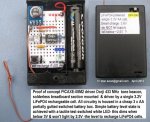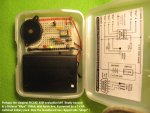Hi group
This is my first post. I have been programming Picaxe for 2 months now and experimenting with RGB bleeder effect to learn commands. When i close my desktop neon lamp to better see the rgb LED, the picaxe jumps in the sequence of colors like it was disrupted. Both are connected to the same surge protected ac supply extension cord. The 14m2 is powered on a standard 7805 circuit, a capacitor recommended for all ICs is also between V+ and 0v. Besides this glitch, everything works well. Is the picaxe sensible to high voltage transformers like ones used to power neons or is there a way to prevent this for future project where disrupting devices should be connected on the same ac power outlet?
Thanks,
Protezoid
This is my first post. I have been programming Picaxe for 2 months now and experimenting with RGB bleeder effect to learn commands. When i close my desktop neon lamp to better see the rgb LED, the picaxe jumps in the sequence of colors like it was disrupted. Both are connected to the same surge protected ac supply extension cord. The 14m2 is powered on a standard 7805 circuit, a capacitor recommended for all ICs is also between V+ and 0v. Besides this glitch, everything works well. Is the picaxe sensible to high voltage transformers like ones used to power neons or is there a way to prevent this for future project where disrupting devices should be connected on the same ac power outlet?
Thanks,
Protezoid


